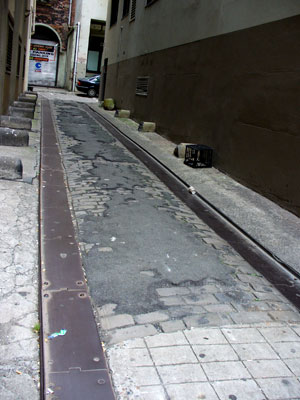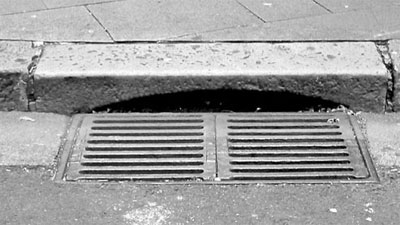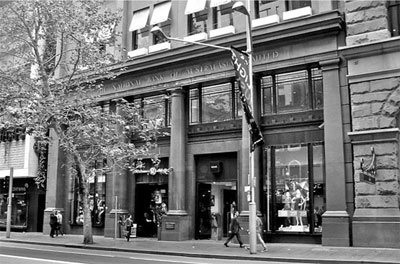The remnants of asphalt and concrete, and the old paving stones underneath, give this laneway in central Sydney a pleasingly shabby appearance. The stones are not cobblestones – as I have been known to mistakenly call them – but pitchers, and in this case pitchers of trachyte. A pitcher is a rectangular stone paving block about 22 cm wide, 30 cm long and 15 cm deep. Trachyte – like granite – is a hard, impervious, igneous (volcanic) rock.
I learnt this from a recently published book, Sydney’s hard rock story: the cultural heritage of trachyte. With its many beautiful illustrations, the book tells a fascinating story.
Quarried from Mount Gibraltar (the Gib) near Bowral in the NSW Southern Highlands, trachyte was first used in the 1880s for paving cubes and for kerb and gutter stones in Sydney, replacing the sandstone flagging that was too easily worn away by the city’s increasing traffic.
But when the durability and imposing appearance of the Bowral trachyte was recognised it was soon incorporated into the design of many grand buildings and monuments, complementing Sydney’s characteristic golden sandstone and investing the buildings with a sense of strength, solidity and permanence. A special feature of Sydney’s hard rock story is its trachyte walk through central Sydney, which takes the curious ambler past over 30 buildings in just a few city blocks.
In parts of Sydney, such as the service lane I photographed, trachyte paving can still be found. And despite the efforts of recent City Councils to remove it, much of the original, roughly-dressed trachyte kerbing and guttering remains as well.
You can find out more about this lovely book at the website, Sydney’s Hard Rock Story. Here are a couple of photographic excerpts:
The Sydney City Council began to use trachyte for kerbs and gutters in the 1880s and the kerbs at the edges of York Street, the ‘frames’ of the drainage inlets and the stormwater lintels are all made of cut trachyte blocks. Similar kerbs, still displaying the textures made by the masons’ tools, can still be seen in almost all of Sydney’s streets.
The former Bank of Australasia (now ‘Paspaley’), on the Martin Place and George Street corner. It was the American architect Edward Raht’s second Sydney building, designed in 1901. The entire building is faced in trachyte, with walls of rock-faced ashlar. The coat-of-arms and the sea-shell motif at the corner pediment represent some of the most detailed trachyte carving in Sydney. The building has two large basement levels which extend outwards for 5 metres beneath Martin Place.
Â
Sydney’s hard rock story: the cultural heritage of trachyte, by Robert Irving, Ron Powell and Noel Irving, published by Heritage Publishing, Sydney and Leura, 2014.



Great blog Megan
Trachyte’s story has waited decades to be told. Anyone who loves urban Sydney will come to absolutely respect, if not love trachyte for what our city owes to this magnificent material